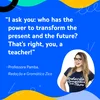These types of feedback are one of the many reasons we recently announced updates to make educational content even more accessible for learners while helping learning creators thrive on YouTube.
Looking ahead, Professora Pamba believes that this is the natural evolution of education. “Schools, in the format we know today, will be even more embedded in technology, as the next generations of students already have a natural digital profile,” she says. More specifically, she sees a world where YouTube is naturally included in schools — whether videos are used to engage an entire classroom or asynchronously to suit an individual student’s needs.
This, in fact, is almost a reality in the US, where 96% of teachers who use YouTube said they use content from the platform in their lessons. Others, like Haichi, have a larger vision. “My dream is to raise learning on YouTube to the same playing field as schools and cram schools, and make it the third pillar that supports education,” he says. ”I see a future where a student asking, ‘Which video are you studying with?’ becomes as common as, ‘Which cram school do you go to?’”
We thank these four educators – and teachers around the world – for making learning better for students, so they can go further in the classroom and beyond.




